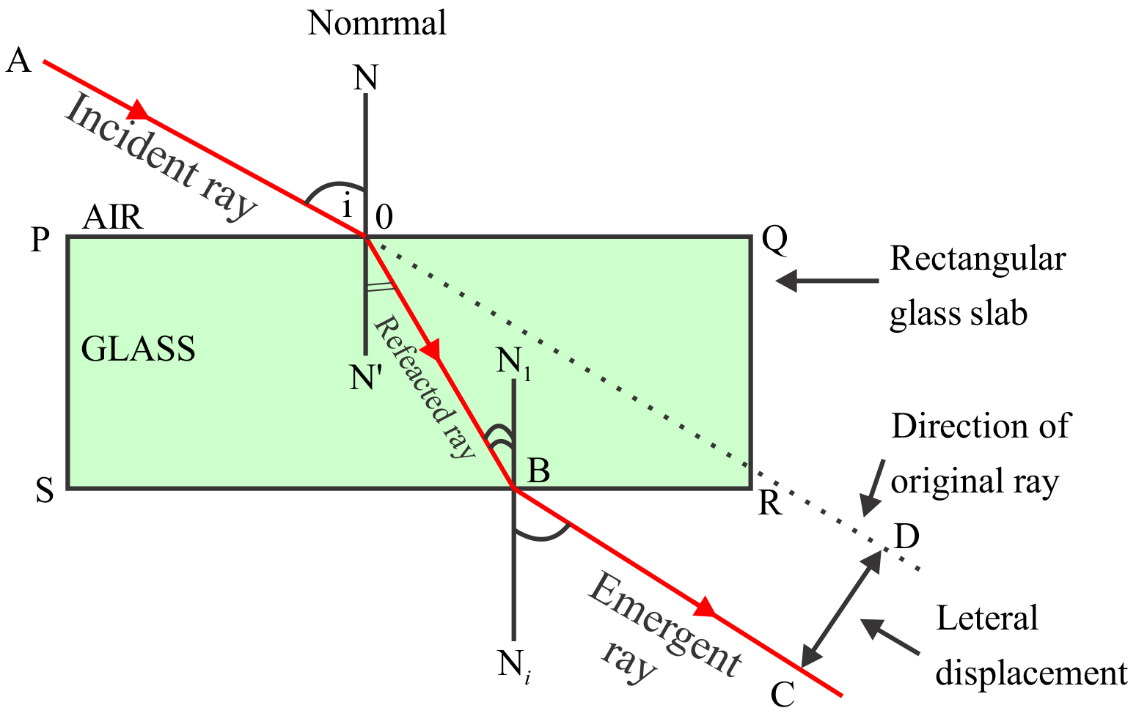
A student very cautiously traces the path of a ray through a glass slab for different values of the angle of incidence $\left( {\angle i} \right)$. He then measures the corresponding values of the angle of refraction $\left( {\angle r} \right)$ and the angle of emergence $\left( {\angle e} \right)$ for every value of the angle of incidence. On analyzing these measurements of angles, his conclusion would be
$\left( a \right)$ $\angle i > \angle r > \angle e$
$\left( b \right)$ $\angle i = \angle e > \angle r$
$\left( c \right)$ $\angle i,\angle r,\angle e$
$\left( d \right)$ $\angle i = \angle e,\angle r$
Answer
133.5k+ views
Hint Angle of incidence is the adequate angle of emergence and angle of incidence is bigger than the angle of refraction additionally angle of refraction is less than angle emergence. By using all the above concepts we can answer the question.
Complete Step by Step Solution We discovered, that once a ray of light passes from rarer medium to denser medium, it diverges toward the normal, and once this refracted lightweight emerges, then it goes away from the normal, once the incident and also the emerging medium is the same then the angle of incidence and also the angle of emerging perpetually are equal.

As the incident ray is parallel to the emerging ray so we will conclude that the angle of incidence is adequate the angle of emergence
And mathematically we can write it as,
$\angle i = \angle e$
And also the ray traveling from the rarer medium which is air, to the denser medium which is glass slab. The ray will slightly bend towards the normal after the refraction.
Thus we can say that the angle of refraction is smaller than the angle of incidence.
$\angle i > \angle r$
Therefore, $\angle i = \angle e > \angle r$ will be the correct option. That is an option$b$.
Note
It may be noted that this is, in general, true only if the normal at the point of incidence and the point of emergence are parallel to each other as in the case of rectangular slabs of the second medium. In the case of a prism, the conventional at the purpose of incidence isn't parallel to the conventional at the purpose of emergence. They are equal only for the angle of minimum deviation.
Complete Step by Step Solution We discovered, that once a ray of light passes from rarer medium to denser medium, it diverges toward the normal, and once this refracted lightweight emerges, then it goes away from the normal, once the incident and also the emerging medium is the same then the angle of incidence and also the angle of emerging perpetually are equal.

As the incident ray is parallel to the emerging ray so we will conclude that the angle of incidence is adequate the angle of emergence
And mathematically we can write it as,
$\angle i = \angle e$
And also the ray traveling from the rarer medium which is air, to the denser medium which is glass slab. The ray will slightly bend towards the normal after the refraction.
Thus we can say that the angle of refraction is smaller than the angle of incidence.
$\angle i > \angle r$
Therefore, $\angle i = \angle e > \angle r$ will be the correct option. That is an option$b$.
Note
It may be noted that this is, in general, true only if the normal at the point of incidence and the point of emergence are parallel to each other as in the case of rectangular slabs of the second medium. In the case of a prism, the conventional at the purpose of incidence isn't parallel to the conventional at the purpose of emergence. They are equal only for the angle of minimum deviation.
Recently Updated Pages
JEE Main 2025 Session 2 Form Correction (Closed) – What Can Be Edited

Sign up for JEE Main 2025 Live Classes - Vedantu

JEE Main Books 2023-24: Best JEE Main Books for Physics, Chemistry and Maths

JEE Main 2023 April 13 Shift 1 Question Paper with Answer Key

JEE Main 2023 April 11 Shift 2 Question Paper with Answer Key

JEE Main 2023 April 10 Shift 2 Question Paper with Answer Key

Trending doubts
JEE Main 2025 Session 2: Application Form (Out), Exam Dates (Released), Eligibility, & More

JEE Main 2025: Conversion of Galvanometer Into Ammeter And Voltmeter in Physics

JEE Main 2025: Derivation of Equation of Trajectory in Physics

Wheatstone Bridge for JEE Main Physics 2025

Electric field due to uniformly charged sphere class 12 physics JEE_Main

Electric Field Due to Uniformly Charged Ring for JEE Main 2025 - Formula and Derivation

Other Pages
JEE Advanced Marks vs Ranks 2025: Understanding Category-wise Qualifying Marks and Previous Year Cut-offs

Diffraction of Light - Young’s Single Slit Experiment

Dual Nature of Radiation and Matter Class 12 Notes: CBSE Physics Chapter 11

If a wire of resistance R is stretched to double of class 12 physics JEE_Main

JEE Advanced 2024 Syllabus Weightage

Current Loop as Magnetic Dipole and Its Derivation for JEE




